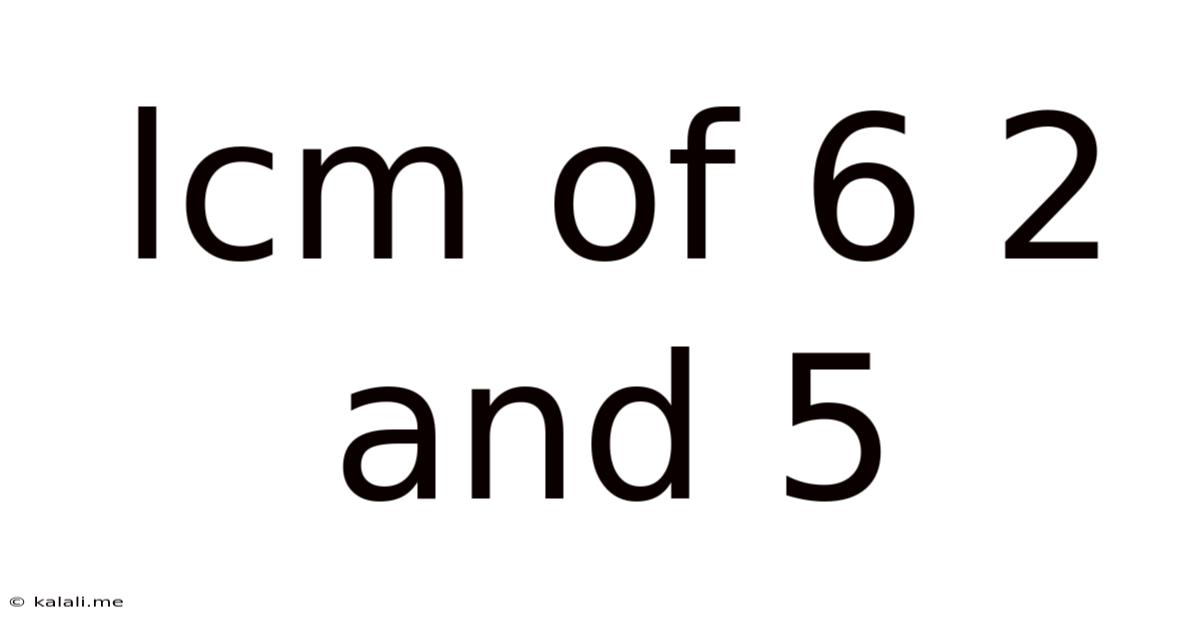Lcm Of 6 2 And 5
Kalali
Jun 11, 2025 · 2 min read

Table of Contents
Finding the Least Common Multiple (LCM) of 6, 2, and 5
This article will guide you through calculating the least common multiple (LCM) of 6, 2, and 5. Understanding LCM is crucial in various mathematical applications, from simplifying fractions to solving problems involving cycles and repetitions. We'll explore different methods to find the LCM, making this concept clear and easy to grasp.
What is the Least Common Multiple (LCM)?
The least common multiple (LCM) of two or more integers is the smallest positive integer that is divisible by all the integers. In simpler terms, it's the smallest number that all the given numbers can divide into evenly. This is different from the greatest common divisor (GCD), which is the largest number that divides all the given numbers without leaving a remainder.
Methods for Finding the LCM of 6, 2, and 5
There are several ways to calculate the LCM, and we'll explore two common methods: the listing method and the prime factorization method.
1. Listing Multiples Method:
This method involves listing the multiples of each number until you find the smallest multiple common to all.
- Multiples of 6: 6, 12, 18, 24, 30, 36, 42, 48, 54, 60...
- Multiples of 2: 2, 4, 6, 8, 10, 12, 14, 16, 18, 20, 22, 24, 26, 28, 30...
- Multiples of 5: 5, 10, 15, 20, 25, 30, 35, 40, 45, 50, 55, 60...
By comparing the lists, we can see that the smallest multiple common to 6, 2, and 5 is 30. Therefore, the LCM(6, 2, 5) = 30. This method is straightforward for smaller numbers but can become cumbersome with larger numbers.
2. Prime Factorization Method:
This method uses the prime factorization of each number to efficiently determine the LCM. Let's break down each number into its prime factors:
- 6 = 2 x 3
- 2 = 2
- 5 = 5
To find the LCM using prime factorization:
- Identify the unique prime factors: In this case, we have 2, 3, and 5.
- Find the highest power of each prime factor: The highest power of 2 is 2¹ = 2, the highest power of 3 is 3¹ = 3, and the highest power of 5 is 5¹ = 5.
- Multiply the highest powers together: 2 x 3 x 5 = 30
Therefore, using the prime factorization method, we again find that the LCM(6, 2, 5) = 30. This method is generally more efficient for larger numbers.
Conclusion:
The least common multiple of 6, 2, and 5 is 30. Both the listing multiples method and the prime factorization method confirm this result. Understanding how to calculate the LCM is a fundamental skill in mathematics with applications in various fields. Choosing the most appropriate method depends on the complexity of the numbers involved; the prime factorization method is generally more efficient for larger numbers.
Latest Posts
Latest Posts
-
How Many Ounces Is A Pint Of Blueberries
Jul 01, 2025
-
How Many Dimes Are In 5 Dollars
Jul 01, 2025
-
How Many Cups Is 12 Oz Of Chocolate Chips
Jul 01, 2025
-
How Do You Beat Level 7 On Bloxorz
Jul 01, 2025
-
What Grade Level Do You Learn Algebra 1
Jul 01, 2025
Related Post
Thank you for visiting our website which covers about Lcm Of 6 2 And 5 . We hope the information provided has been useful to you. Feel free to contact us if you have any questions or need further assistance. See you next time and don't miss to bookmark.